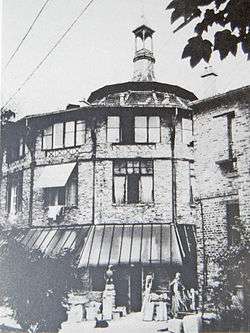La Ruche

La Ruche (literally the beehive) was an artist's residence in the Montparnasse district of Paris.
Located in the "Passage Dantzig," in the 15th arrondissement of Paris, La Ruche was an old three-storey circular structure that got its name because it looked more like a large beehive than any dwelling for humans. Originally a temporary building designed by Gustave Eiffel for use as a wine rotunda at the Great Exposition of 1900, the structure was dismantled and re-erected as low-cost studios for artists by Alfred Boucher (1850–1934), a sculptor, who wanted to help young artists by providing them with shared models and with an exhibition space open to all residents. As well as to artists, La Ruche became a home to the usual array of drunks, misfits, and almost every penniless soul needing a roof over their head.
At La Ruche the rent was dirt cheap; and no one was evicted for non-payment. When hungry, many would wander over to artist Marie Vassilieff's soup kitchen (more genteelly called her "Cantine") for a meal and conversation with fellow starving artists. The Russian painter Pinchus Kremegne got off the train at the Gare de l'Est with three rubles in his pocket. The only words in French he knew was the phrase "Passage Dantzig"; but that was all he needed to get him there.
In the history of mankind, like Montparnasse or Montmartre, few places have ever housed such artistic talent as could be found at La Ruche. At one time or another in those early years of the 20th century, Guillaume Apollinaire, Alexander Archipenko, Joseph Csaky, Gustave Miklos, Alexandre Altmann, Ossip Zadkine, Moise Kisling, Marc Chagall, Max Pechstein, Nina Hamnett, Fernand Léger, Jacques Lipchitz, Pinchus Kremegne, Max Jacob, Blaise Cendrars, Chaim Soutine, Robert Delaunay, Amedeo Modigliani, Constantin Brâncuși, Amshey Nurenberg, Diego Rivera, Marevna, Luigi Guardigli, Michel Sima, Marek Szwarc and others, called the place home or frequented it. Today, works by some of these desperately poor residents and their close friends sell well, even in the millions of dollars.
La Ruche went into decline during World War II; and by the time of the 1968 real estate boom, it was threatened with demolition by developers. However, with the support of luminaries such as Jean-Paul Sartre, Alexander Calder, Jean Renoir, and René Char, new management with a preservation mission took over in 1971, turning it into a collection of working studios.
Its interior is not open to the general public, although the exterior of La Ruche alone is worth a visit. Paintings, sculptures, photographs from its heyday and films showing some of its residents may be viewed at the Musée du Montparnasse, 21 av du Maine.
See also
- Le Bateau-Lavoir, in Montmartre, Paris.
External links
- "Another Wild-Goose Chase – No Sign of the 'Beehive'" (Travel diary with photographs)
- Guillaume, "Françoise and Modigliani at La Ruche – Adventures In Montparnasse" (Travel diary with photographs)
Coordinates: 48°49′57″N 2°17′49″E / 48.83250°N 2.29694°E